Assignment:
1. In 2286, Admiral Kirk and his crew were forced to use the sling shot effect in a stolen Klingon Bird-of-Prey to travel back in time to the late 20th century to retrieve two humpback whales. The stolen Klingon Bird-of-Prey traveled towards the sun at a velocity of v, while the sun was moving towards them at a velocity of u, then traveled around the sun (using the sun's gravitational field) such that the stolen Klingon Bird-of-Prey was now moving in the opposite direction from whence it started, with a new velocity, vnew. Find vnew in terms of u and v, assuming the mass of the sun is much larger than the mass of the spaceship.
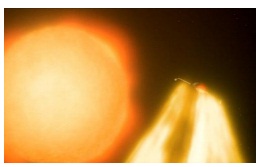
2. Consider holding a carton of milk in your hand, as shown in the image. The force of the bicep muscle acts at an angle of 15o to the vertical, while the weight of the arm and the milk both act downwards. The distance from the elbow to where the bicep muscle is attached via the the distal bicep tendons to the radius and ulna bones is 5 cm. The distance from the elbow to the center of mass of the forearm is 16.5 cm and the distance from the elbow to the hand, holding the milk, is 35 cm. The forearm has a mass of 4 kg and the milk carton a mass of 2 kg.
a) Assuming the forearm, is kept perfectly horizontal, find the tension in the bicep muscle.
b) As a function of the angle of the forearm with respect to the horizontal direction (as the forearm is lowered) calculate the tension in the bicep muscle.
c) Include a plot of tension in the bicep as a function of the angle of the forearm relative to the horizontal (don't forget to label axis).
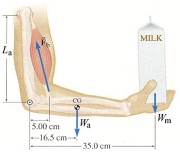
3. An aortic aneurysm exists as a bulging out of the aorta walls, where the aorta walls are actually more elastic than normal aorta walls, and deform more in response to the blood pressure in the aorta. If the radius of the aorta is typically 1 cm and the blood flow rate is 100 cm3 s-1, how much would the pressure increase in the aortic aneurysm if the radius of the aneurysm is 3 cm? Assume that the blood vessel is horizontal and ignore the viscous nature of blood.
4. You hold a hose at 45o to the horizontal and at a height of 1 m from the floor. The water reaches a maximum distance of 10 m from where you are standing. Now you place your thumb over the end of the hose to occlude the opening by 80%, which in turn reduces the flow rate by 50%. Even though less fluid emerges the water travels further?
a) How far does the water travel with your thumb over the end of the hose (assuming the height and angle remain the same)?
b) Assume the flow rate (as a percentage of original flow rate) can given by
Q% = 100 [1-(A%/100)5]
where is the percentage by which the opening of the hose is occluded. Notice that if is 0% then is 100%, whereas if is 100% then is 0%. Find the amount by which the hose must be occluded in order for the water to travel twice as far (assuming the height and angle remain the same).
5. Assume the muscle is 37oC and is separated from the outside air by layers of fat and skin. The layer of fat, at a particular location on the skin, is 2 mm thick and has a conductivity of 0.16 W m-1 K-1. Above this is a 1.1 mm dermis layer with a thermal conductivity of 0.53 W m-1 K-1. Finally, the outermost epidermal layer is 0.1 mm thick with a thermal conductivity of 0.21 W m-1 K-1. How much heat is lost per unit area nd unit time if the ambient air temperature is 0oC?
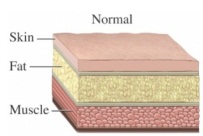
6. A ball is thrown from the top of a roof at an angle of 20o with respect to the vertical. 1 s later a ball is dropped from the top of the roof.
a) If the height of the roof is 20 m, determine the velocity with which the first ball must be thrown in order for both balls to land at exactly the same time.
b) Imagine the velocity of the first ball is now known, and instead it is the height of the building which is unknown. Can you obtain an equation for the height of the building which would result in both balls landing on the floor at the same time.
7. You are firing a cannonball from the top of a cliff at a pirate ship which is behind a mountain. The height of the cannon is 100 m, the height of the mountain is 120 m, and the height of the pirate ship is 70 m.
The mountain is horizontally 200 m away from cannon, while the pirate ship is horizontally 270 m away from the cannon.
The speed of the cannonball after it is fired is 65 m s-1. You could hit anywhere from the bottom of the pirate ship to the top in order to sink it. Over what angles could you fire the cannonball to sink the pirate ship?
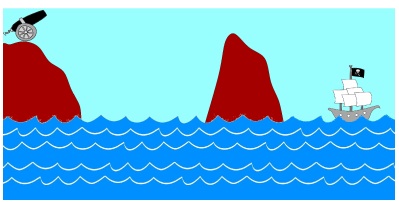
8. Consider the pulley system to the right. The masses M and 3 M are simply hanging, while the mass 2 M is sitting on an inclined plane with coefficients of friction μs and μk .
a) Obtain an expression for the coefficient of static friction required to ensure the masses do not accelerate, which depends on the angle of the inclined surface.
b) Obtain an expression for the coefficient of kinetic friction required to ensure the masses move at a constant velocity when they do move, which depends on the angle of the inclined surface.
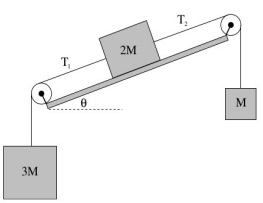
9. A bullet of mass m and initial velocity v0 passes through a block of mass M suspended by an unstretchable, massless string of length L from an overhead support. It emerges from the collision on the far side traveling at v1 < v0. This happens extremely quickly (before the block has time to swing up) and the mass of the block is unchanged by the passage of the bullet (the mass removed making the hole is negligible, in other words). After the collision, the block swings up to a maximum angle θmax and then stops. Find θmax.
10. In the figure above, a spool or pulley with moment of inertia βMR2 is hanging from a ceiling by a (massless, unstretchable) string that is wrapped around it at a radius R, while a block of equal mass M is hung on a second string that is wrapped around it at a radius r as shown. Find the magnitude of the acceleration of the the central pulley.
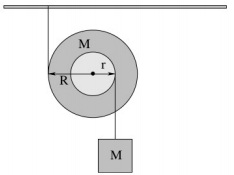
11. Write 5 multiple-choice exam questions on any topics of your choice. A good question should be of sufficient difficulty and perhaps have a good background story? Try to change questions you've seen previously? Post your favorite question to the blackboard discussion board!